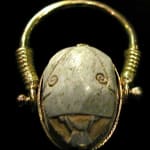Finger-Ring with Scarab
0.75
LO.1143
The ancient Egyptians maintained that the sun was propelled across the heavens by means of a scarab, or sacred beetle. With the passing of time, the Egyptians created a series...
The ancient Egyptians maintained that the sun was propelled across the heavens by means of a scarab, or sacred beetle. With the passing of time, the Egyptians created a series of amulets in the form of this beetle in a great variety of materials, and these were routinely provided with inscriptions in hieroglyphs conveniently accommodated to their stylized flat bottoms. Such scarabs were generally incorporated into finger rings, as here, where they served as bezels.
Our scarab is just such a variation with a remarkable degree of ornamentation on its upper side. The head with its eyes, the plate, and the clypeus are well articulated. Although the thorax and elytra, or wing case, which are simply indicated by a single, V-shaped notch on each side of the beetle’s body, the elytra is itself ornamented with an asymmetrically designed, double cruciform element over which a series of dotted concentric circles in two groups of four at the top and bottom have been superimposed. Although such patterns are a common decorative element on scarabs of the period, scholars have yet to convincingly identify their meaning. Nevertheless, such motifs, which may have originally been imbued with magical properties, were first introduced in the Middle Kingdom and were repeatedly encountered on scarabs of later periods. The curl design on the elytra is likewise attested during the period to which our scarab is assigned.
Scarab finger-rings, mounted in settings with swivel bezels, as seen here in our finger ring, are attested from the time of the Middle Kingdom and become particularly popular in the New Kingdom.
References:
For a discussion of these designs, see, Daphna Ben-Tor, The Scarab. A Reflection of Ancient Egypt (Jerusalem 1993, page 31; and Carol Andrews, Ancient Egyptian Jewellery (London 1990), page 164, for a discussion of these finger rings.
Translation and interpretation kindly provided by Prof. Robert S. Bianchi.
Our scarab is just such a variation with a remarkable degree of ornamentation on its upper side. The head with its eyes, the plate, and the clypeus are well articulated. Although the thorax and elytra, or wing case, which are simply indicated by a single, V-shaped notch on each side of the beetle’s body, the elytra is itself ornamented with an asymmetrically designed, double cruciform element over which a series of dotted concentric circles in two groups of four at the top and bottom have been superimposed. Although such patterns are a common decorative element on scarabs of the period, scholars have yet to convincingly identify their meaning. Nevertheless, such motifs, which may have originally been imbued with magical properties, were first introduced in the Middle Kingdom and were repeatedly encountered on scarabs of later periods. The curl design on the elytra is likewise attested during the period to which our scarab is assigned.
Scarab finger-rings, mounted in settings with swivel bezels, as seen here in our finger ring, are attested from the time of the Middle Kingdom and become particularly popular in the New Kingdom.
References:
For a discussion of these designs, see, Daphna Ben-Tor, The Scarab. A Reflection of Ancient Egypt (Jerusalem 1993, page 31; and Carol Andrews, Ancient Egyptian Jewellery (London 1990), page 164, for a discussion of these finger rings.
Translation and interpretation kindly provided by Prof. Robert S. Bianchi.



